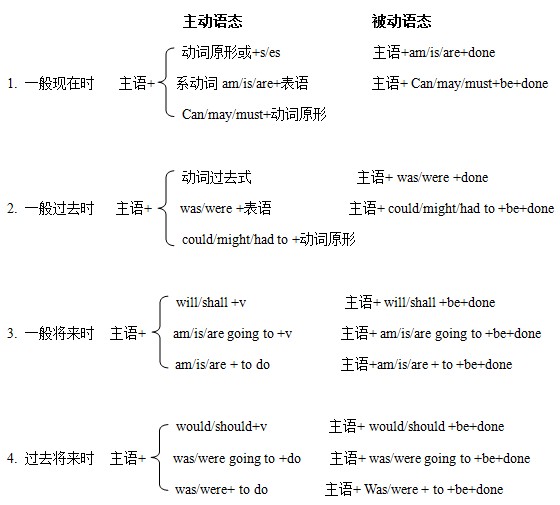基本介紹
- 類型:英文
- 形式:主動被動形態

主動語態是表示主語是謂語動作的使動方的語態。在主動語態中,謂語的動作源自主語,而施加於賓語。相反,在被動語態中,主語是謂語動作的受動方。...
被動語態(passive voice)是動詞的一種形式,用以說明主語與謂語動詞之間的關係。英語的語態共有兩種:主動語態和被動語態。主動語態表示主語是動作的執行者,被動語態...
語態是動詞的一種形式,用以說明主語與謂語動詞之間的關係。常見語態有主動語態、被動語態和中間語態。英語的語態共有兩種:主動語態和被動語態。主動語態表示主語是...
被動語態,即不知道動作執行者或強調動作承受者的一種語態。英語的語態是通過動詞形式的變化表現出來的。英語中有兩種語態:主動語態和被動語態。主動語態表示主語是...
動詞語態是指特殊的動詞形式,用以表示動作的主語和賓語之間的關係。...... 英語的語態有兩種:主動語態和被動語態。主動語態中主語是動作的執行者,被動語態中主語是...
主動語態4. 有功的;有源的出處1. 主持發動。陳春生《庚戌廣州新軍舉義記·黨人之被害》:“據供此次起事,實為革命黨從中主動。”...
語態是動詞的一種形式,用以說明主語與謂語動詞之間的關係。英語的語態共有兩種:主動語態和被動語態。主動語態表示主語是動作的執行者,被動語態表示主語是動作的承受...
”時態“表示不同時間發生的動作或存在的狀態,需要用不同的動詞形式表示。在英語語法中,“時“指動作發生的時間,”態“指動作的樣子和狀態。”語態“是一種動詞...
《原來英語動詞的語態這樣用》以教育部最新頒布的2011版《英語課程標準》和人教版中學英語教材為指導,系統歸納全國各省市中考和高考的最新英語知識考點。共分10講,...
《薄冰國中英語語法之12・動詞語態》是薄冰創作的教育考試類書籍。...... 語態有兩種形式:主動語態和被動語態。如果主語是動作的執行者,謂語動詞用主動語態。如果主...
現在進行時由主動語態變被動語態時應注意以下一些問題:1、也像其它時態由主動語態變被動語態一樣,首先弄清楚用現在進行時的句子中哪些可以由主動語態變為被動語態。...
謂語動詞的語態表示句子的主語和謂語動作之間的關係1)當句子的主語是謂語動作的執行者時,主、謂之間的關係稱為主動語態;2)當句子的主語是謂語動作的承受者時,主...
相反,被動語態中,主語是謂語動作的受動方,如果有賓語的,賓語往往是謂語動作的使動方。在語法機構上,主動語態和被動語態的區別主要在於,主動語態直接使用動詞原形...
(一般過去時主動語態) It is used by travelers and business people all over the world.全世界旅行者和商人都使用它 (is used為謂語, 一般現在時被動語態)...
(被動態則是amāri),詞幹為ama-,加-o後綴縮約為amo,表示直陳語氣(indicative mood)、主動語態(active voice)、第一身、單數和現在式,無論更改上列的任何一種...
(語態)動詞和參與此動作的主語之間關係的一個術語。當主語是動作的發起者(或之一)時,稱為主動語態; 如果動詞不定式的邏輯主語是這個不定式所表示的動作的承受者,...
